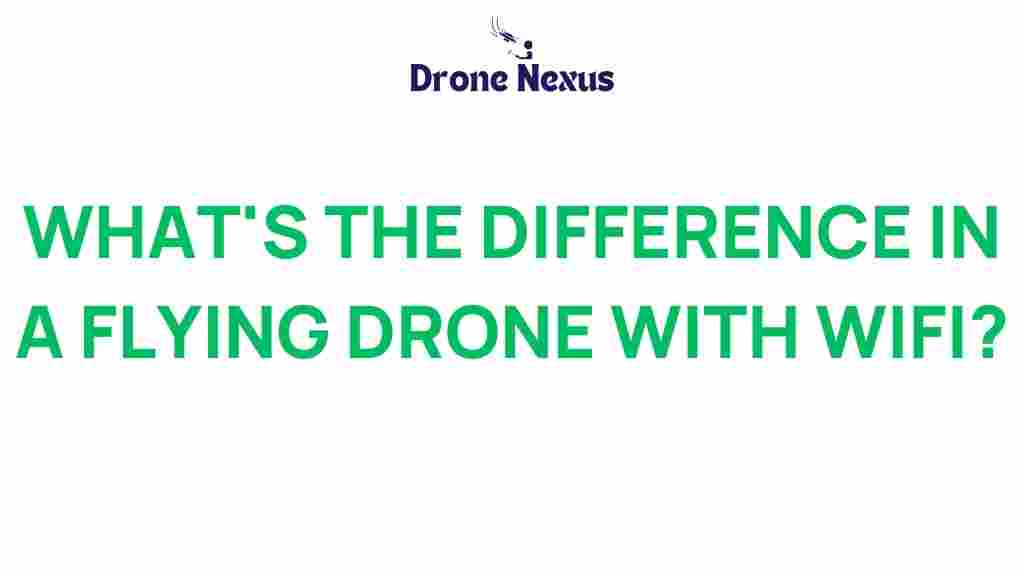Wi-Fi Drones: What Sets Them Apart?
In recent years, technology has advanced at a breakneck speed, giving rise to innovative devices that enhance our daily lives. Among these gadgets, Wi-Fi drones have captured the attention of hobbyists, professionals, and tech enthusiasts alike. But what exactly sets Wi-Fi drones apart from their traditional counterparts? This article will explore the unique features and benefits of Wi-Fi drones, their applications, and how to troubleshoot common issues.
Understanding Wi-Fi Drones
Before delving into the specifics of what makes Wi-Fi drones unique, it’s essential to understand what they are. Wi-Fi drones are unmanned aerial vehicles (UAVs) that utilize Wi-Fi technology for communication and control. Unlike traditional drones that may rely on radio frequencies, Wi-Fi drones connect to smartphones, tablets, or laptops, allowing for an enhanced user experience.
Key Features of Wi-Fi Drones
Several features distinguish Wi-Fi drones from other types of drones:
- Real-time Video Streaming: One of the most exciting aspects of Wi-Fi drones is their ability to stream video in real-time. This feature is particularly beneficial for aerial photography, surveillance, and even search-and-rescue operations.
- Ease of Use: Wi-Fi drones are generally user-friendly, making them accessible to beginners. Most models come with intuitive mobile apps that facilitate easy control and navigation.
- Extended Range: While traditional drones often have limited range due to radio signal constraints, Wi-Fi drones can offer an extended range, depending on the strength of the Wi-Fi signal.
- Advanced Features: Many Wi-Fi drones come equipped with GPS capabilities, allowing for features like waypoint navigation and return-to-home functions.
- Cost-Effective: As technology has progressed, the cost of Wi-Fi drones has decreased, making them more affordable for consumers. This has led to widespread adoption in various sectors.
Applications of Wi-Fi Drones
Wi-Fi drones have a plethora of applications across different industries:
- Aerial Photography: Photographers can capture stunning images and videos from unique angles, providing a fresh perspective on landscapes and events.
- Surveying and Mapping: In construction and agriculture, Wi-Fi drones are used to create accurate maps and surveys, saving time and resources.
- Security and Surveillance: Businesses and law enforcement utilize Wi-Fi drones to monitor large areas, ensuring safety and security.
- Search and Rescue: In emergency situations, Wi-Fi drones can help locate missing persons or assess damage after natural disasters.
- Delivery Services: Companies are exploring the use of Wi-Fi drones for quick and efficient delivery of packages, especially in remote areas.
How to Get Started with Wi-Fi Drones
If you’re considering diving into the world of Wi-Fi drones, follow this step-by-step guide:
Step 1: Research and Choose Your Drone
It’s crucial to research various models of Wi-Fi drones. Look for reviews, specifications, and user experiences. Consider factors like battery life, flight time, camera quality, and range. Popular models include:
- DJI Mini 2
- Holy Stone HS720
- Parrot Anafi
Step 2: Download the Necessary Apps
Most Wi-Fi drones come with a companion app that allows you to control the drone from your smartphone. Download the appropriate app before your first flight.
Step 3: Conduct a Pre-Flight Check
Before flying, ensure that:
- The drone is fully charged.
- The propellers are intact and properly attached.
- There are no obstructions in the flight area.
Step 4: Familiarize Yourself with Controls
Before taking off, spend some time getting to know the controls. Practice basic maneuvers to understand how the drone responds.
Step 5: Start Flying
Once you’re comfortable, it’s time to take to the skies! Start with small, controlled flights to build your confidence.
Troubleshooting Common Wi-Fi Drone Issues
Even with the best technology, issues can arise. Here are some common problems and their solutions:
Problem 1: Weak Wi-Fi Signal
If you experience a weak signal, try the following:
- Move closer to the drone.
- Ensure there are no physical obstructions like trees or buildings.
- Check for interference from other Wi-Fi networks.
Problem 2: Drone Won’t Connect to App
If your drone fails to connect to the app:
- Restart both the drone and your smartphone.
- Make sure Bluetooth is enabled on your device.
- Reinstall the app if necessary.
Problem 3: Unstable Flight
For drones that exhibit unstable flight, consider these tips:
- Calibrate the drone’s compass.
- Check for damaged propellers.
- Ensure the drone is flying in an open area with minimal wind.
Conclusion
In conclusion, Wi-Fi drones are a fascinating and versatile addition to the technological landscape. Their unique features, such as real-time video streaming and user-friendly controls, set them apart from traditional drones. With applications ranging from aerial photography to search-and-rescue operations, Wi-Fi drones have proven to be invaluable tools across various industries. By following the steps outlined in this article, you can embark on your journey into the world of Wi-Fi drones, equipped with the knowledge to troubleshoot common issues and maximize your flying experience.
For more information on the latest trends in drone technology, visit DroneDJ. If you wish to explore other types of drones, check out our guide on different drone models!
This article is in the category Technology and created by DroneNexus Team
